

Subscription Center. The digital melting pot: Bridging the digital native-immigrant divide. Educational technology advocates claim today’s students are technologically savvy content creators and consumers whose mindset differs from previous generations.

The digital native–digital immigrant metaphor has been used to make a distinction between those with technology skills and those without. Metaphors such as this one are useful when having initial conversations about an emerging phenomenon, but over time, they become inaccurate and dangerous. Thus, this paper proposes a new metaphor, the digital melting pot, which supports the idea of integrating rather than segregating the natives and the immigrants. ContentsIntroductionDiscussionConclusion Introduction Young people are viewed as prolific users of technology.
A common stereotype of today’s student is of an individual who is adept at multitasking both off–line and online and who is constantly connected — always in touch — anytime, anyplace. A Great Cities Initiative of the University of Illinois at Chicago University Library. The digital melting pot: Bridging the digital native-immigrant divide.
DIGITAL IMMIGRANTS & DIGITAL NATIVES: The Digital Divide in Psychotherapy. The Digital Divide in Psychotherapy: At Home, School, in the Workplace and in...
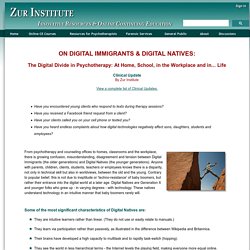
Life Clinical UpdateBy Zur Institute View a complete list of Clinical Updates. Have you encountered young clients who respond to texts during therapy sessions? Have you received a Facebook friend request from a client? Subscription Center. How Chicago is Narrowing the Digital Divide. This story was originally published by Data-Smart City Solutions.
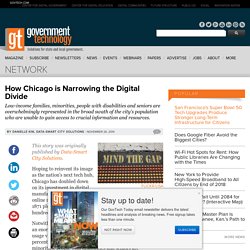
Hoping to reinvent its image as the nation’s next tech hub, Chicago has doubled down on its investment in digital manufacturing and technology. This summer, the global online marketplace eBay and the high-profile tech incubator 1871 pledged to expand their presence in Chicago and to add hundreds of tech-savvy jobs to the city’s growing workforce. Notwithstanding these successes, Chicago remains plagued by an enormous connectivity gap. In the Windy City, broadband usage varies widely, ranging from just 36 percent to 94 percent for a given neighborhood. Eliminate the Digital Divide – Smart Chicago. Last week, I traveled with Kyla Williams, Sonja Marziano, and Christopher Whitaker to Kansas City, MO for the Gigabit City Summit – A three-day learning and networking opportunity exclusively designed for leaders in current and emerging Gigabit Cities.
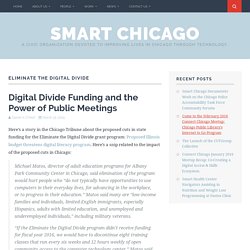
Gigabit City Summit The host city of Kansas City was chosen to be the first city with Google Fiber. Gigabit cities have internet download speeds of up to one gigabit of data per second. To compare, Chicago has an average internet download speed of 23 mbs/s. Clearly, this gives Kansas City a significant advantage. Bridging the New Digital Divide. At the highest performing urban school in the city of Providence, Rhode Island, the mantra when it comes to education is "children always come first.
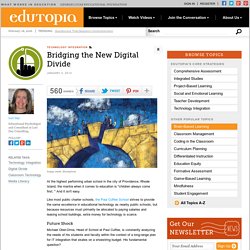
" And it isn't easy. Like most public charter schools, the Paul Cuffee School strives to provide the same excellence in educational technology as nearby public schools, but because resources must primarily be allocated to paying salaries and leasing school buildings, extra money for technology is scarce. Future Shock Michael Obel-Omia, Head of School at Paul Cuffee, is constantly analyzing the needs of his students and faculty within the context of a long-range plan for IT integration that skates on a shoestring budget.
His fundamental question? In March of 2010, no one had even heard of an iPad. Technology is a tool, not a solution. Striking a Virtual-Actual Balance. Digital Divide: The Technology Gap between the Rich and Poor — Digital Responsibility. Even as technology becomes more affordable and internet access seems increasingly ubiquitous, a “digital divide” between rich and poor remains.
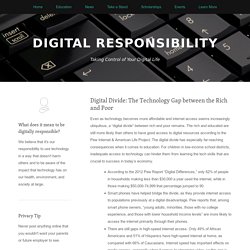
Early Education Plays Role in Bridging the 'Digital Divide' MondayMarch 3, 2014 A new RAND Corporation report issued today outlines issues that educators, policymakers and others must address to make better use of technology in the modern classroom and help close the “digital divide” that separates low-income students and their more-advantaged peers.
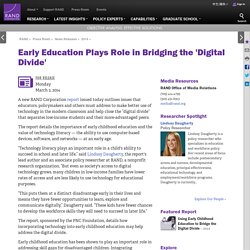
The report details the importance of early childhood education and the value of technology literacy — the ability to use computer-based devices, software, and networks — at an early age. “Technology literacy plays an important role in a child's ability to succeed in school and later life,” said Lindsay Daugherty, the report's lead author and an associate policy researcher at RAND, a nonprofit research organization. “But even as society's access to digital technology grows, many children in low-income families have lower rates of access and are less likely to use technology for educational purposes. As soon as 2015, most states will move to computer-based standardized testing.
Bridging the Digital Divide in Education. Why It's So Hard to Close the Digital Divide in High-Poverty Schools. PHILADELPHIA—When it comes to speedy Internet access in schools, which technology advocates say will be critical to ensuring that American students stay competitive globally, Philadelphia is way ahead of many districts across the country.
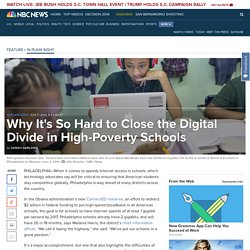
In the Obama administration’s new ConnectED initiative, an effort to redirect $2 billion in federal funding to put high-speed broadband in all American schools, the goal is for schools to have Internet speeds of at least 1 gigabit per second by 2017. Philadelphia schools already have 2 gigabits, and will have 20 in 18 months, says Melanie Harris, the district’s chief information officer. “We call it laying the highway,” she said. “We’ve put our schools in a great position.” It’s a major accomplishment, but one that also highlights the difficulties of bringing technology to the nation’s neediest kids. The speedy Internet does students and teachers little good in many Philadelphia schools. Many American school systems are in a similar situation. Education Week.